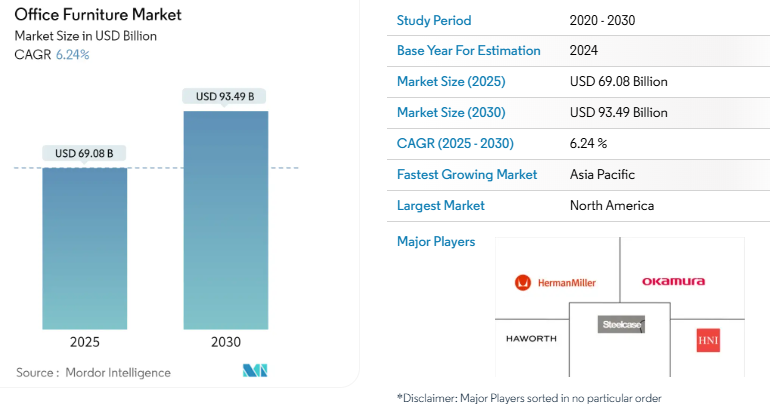Mordor Intelligence has published a new report on the Office Furniture Market, offering a comprehensive analysis of trends, growth drivers, and future projections.
The global office furniture market is experiencing significant growth, propelled by the expansion of commercial spaces and a rising emphasis on ergonomic designs to enhance workplace productivity. According to Mordor Intelligence, the market size is estimated at USD 69.08 billion in 2025 and is expected to reach USD 93.49 billion by 2030, reflecting a compound annual growth rate (CAGR) of 6.24% during the forecast period.
Key Trends
Expansion of Commercial Office Spaces
The global increase in commercial construction activities, particularly in emerging economies, is a primary driver of the office furniture market. As businesses expand and new companies emerge, the demand for modern office spaces equipped with functional and aesthetically pleasing furniture has risen. This trend is further supported by urbanization and the growth of the service sector, leading to a surge in office establishments requiring appropriate furnishings.
Emphasis on Ergonomic and Sustainable Furniture
There is a growing awareness of the importance of ergonomics in the workplace, leading companies to invest in furniture that promotes employee well-being and productivity. Ergonomically designed chairs, adjustable desks, and supportive accessories are becoming standard in modern offices. Additionally, sustainability has become a key consideration, with manufacturers focusing on eco-friendly materials and processes to meet consumer demand for environmentally responsible products.
Rise of Remote Work and Home Office Setups
The COVID-19 pandemic has accelerated the adoption of remote work, resulting in increased demand for home office furniture. Employees are seeking comfortable and functional furniture to create productive workspaces at home. This shift has prompted manufacturers to develop versatile and space-efficient furniture solutions tailored to residential environments.
Report Overview: https://www.mordorintelligence.com/industry-reports/office-furniture-market
Market Segmentation
The office furniture market is segmented based on type, distribution channel, and geography:
By Type:
- Seating: Includes ergonomic chairs, executive chairs, and guest seating designed to provide comfort and support.
- Tables: Encompasses conference tables, meeting tables, and collaborative workstations facilitating group interactions.
- Storage: Comprises filing cabinets, shelves, and storage units for organized document management.
- Desks: Covers various desk types, including adjustable-height desks and computer desks, catering to diverse work needs.
- Other Office Furniture: Encompasses accessories and supplementary furniture items enhancing office functionality.
By Distribution Channel:
- Home Centers: Retail outlets offering a wide range of home and office furniture products.
- Flagship Stores: Brand-specific stores providing exclusive furniture collections.
- Specialty Stores: Retailers focusing on specific furniture categories or styles.
- Online Stores: E-commerce platforms enabling convenient purchasing options.
- Other Distribution Channels: Includes wholesalers and direct sales channels.
By Geography:
- North America: Currently holds the largest market share, driven by a strong economy and significant commercial construction activities.
- Europe: A mature market with a focus on design and sustainability in office furniture.
- Asia-Pacific: Identified as the fastest-growing region, attributed to rapid urbanization and industrialization.
- Latin America: Emerging market with increasing investments in commercial infrastructure.
- Middle East and Africa: Gradual market development with growing demand for modern office setups.
Get a Customized Report Tailored to Your Requirements. – https://www.mordorintelligence.com/market-analysis/office-furniture
Key Players
The office furniture market is characterized by the presence of several key players driving innovation and competition:
- Steelcase Inc.: A leading manufacturer offering a comprehensive range of office furniture solutions emphasizing sustainability and design.
- Herman Miller Inc.: Renowned for its ergonomic and innovative furniture designs enhancing workplace productivity.
- Haworth Inc.: Provides adaptable and sustainable office furniture solutions catering to dynamic work environments.
- HNI Corporation: Offers a diverse portfolio of office furniture products focusing on quality and functionality.
- Okamura Corporation: A prominent player known for its high-quality office furniture integrating advanced technology and design.
These companies are investing in research and development to introduce innovative products that meet evolving workplace needs. Strategies such as mergers, acquisitions, and partnerships are also prevalent as firms aim to expand their market presence and cater to a broader customer base.
Conclusion
The global office furniture market is poised for substantial growth, driven by the expansion of commercial spaces, a heightened focus on ergonomic and sustainable designs, and the evolving dynamics of remote work. As businesses and individuals continue to prioritize functional and comfortable work environments, the demand for innovative office furniture solutions is expected to rise. With ongoing investments in design and technology, the industry is well-positioned to meet the diverse needs of modern workspaces in the coming years.
Industry Related Reports

